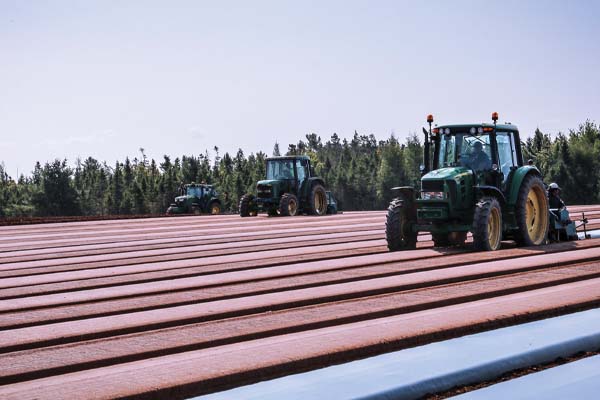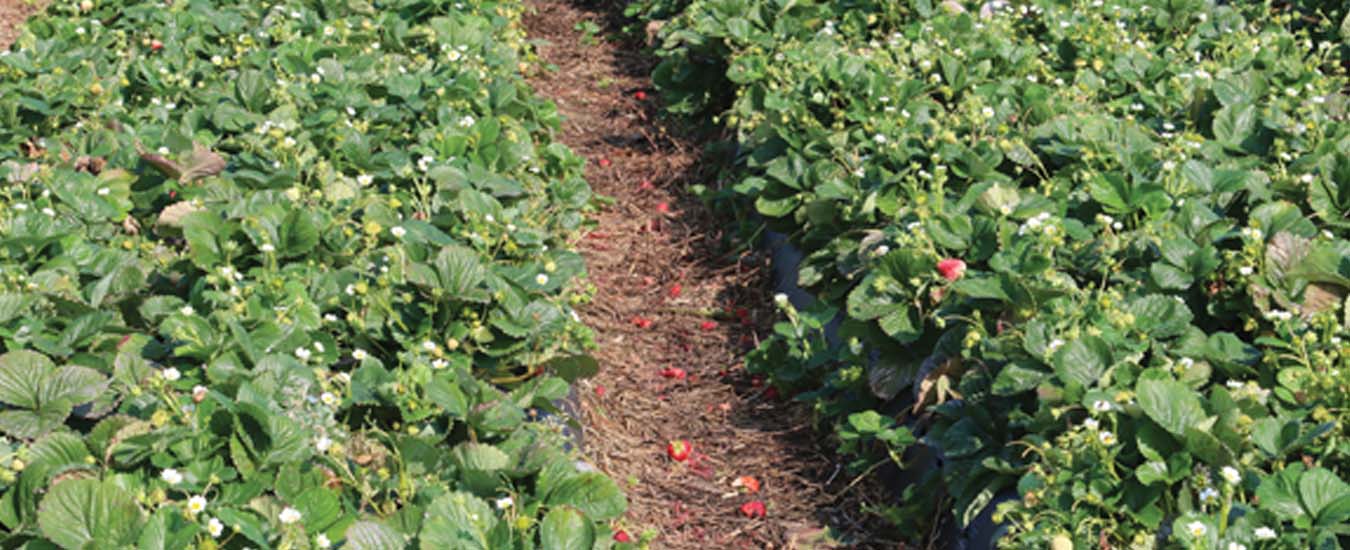Growing quality berries for his customers is in this farmer’s DNA
The world smells of strawberries.
The “world” in this case is a large, sunny field in Great Village, NS, on Cobequid Bay not far from Truro. It is a perfect, late summer day in mid-September. Dozens of people are assembling at the edge of the field, carrying boxes and flats of huge, perfectly ripe, just-picked strawberries. Harvesting done for the day, they climb on to a couple of buses, and the farm owner, Curtis Millen, jumps aboard one and drives it back to the residences he has for his seasonal staff. I follow, driving his truck back to his office where we can talk about his experiences as a farmer who makes fresh local berries available for four months of the year.
Curtis grew up near a farmer in Great Village named Noble Spencer, and used to help him with tending his cattle. One day when Curtis was 14, the farmer said if the teenager would help do the strawberry weeding the following year, Noble would give him six rows of strawberries to be his. That worked out well, so the following year Noble offered him 20 rows; then they split three acres, then five, and eventually Curtis ended up buying the balance of his mentor’s berry production.
In 1980, Curtis started clearing land in Little Dyke, and continues to clear land each year for strawberry production. Today, he grows nearly 200 acres of strawberries, and is a “fairly major supplier” for Sobeys stores throughout the region, as well as other retailers. His family also owns or manages about 400 acres of wild blueberries. In peak season, Millen Farms can employ 250 or more, primarily for harvesting and land development. Curtis’ wife Ann and two other women work in the office managing payroll and accounts, and two of their sons also work on the farm.
Most people know of strawberries as a fresh, luscious fruit available locally for only three or four weeks of the year. These plants produce one crop each year in late spring/early summer, using what is called the “matted row” production method. Curtis says, “In more recent years, day-neutral (or so-called ever-bearing varieties) were developed in California, and seven or eight years ago we became interested in trying them.” Today, more than half the farm acreage is grown on black plastic similar to cultivation methods used in Florida and California, and more than half the acreage is made up of the newer, day-neutral varieties.
Curtis explains the advantages of growing on black plastic. “It covers your soil, and has two drip tapes under it, so you don’t get excessive moisture in your bed to dilute your nutrients—the rain won’t carry it away, and the nutrients are delivered right to the plant roots. There are no weeds, and the plants do very well.”

Tractors move across a new field being cultivated and prepared for next year’s crop of strawberries.
The farm replants new strawberry plants each year, because as they get older they get bushier, the fruit gets smaller and harder to pick, and it’s just more practical to replant to maintain production and quality. Although the three day-neutral varieties the farm grows were developed in the US, one of the early-season varieties, ‘AAC Lila’, was developed at the Agriculture and Agri-Food Canada research station in Kentville, NS by Dr. Andrew Jamieson, a long-time researcher and breeder of quality strawberry varieties suited for growing in our region.
There is a downside to growing on black plastic, however; if the fruit is ripe and you get an extended period of rain, it’ll spoil the “nose” or tip, of the berries and they aren’t saleable. “There’s no way to rescue the fruit for processing, it’s not worth the expense, and the only way to rescue it is with people who can harvest it when you need to harvest.” Curtis watches the weather radar constantly, and when the crop is ready, mobilizes his crews to go in and pick, sometimes twice a day, avoiding the heat of midday. “There are few places hotter than a strawberry field in the middle of summer,” he says.
The traditional plants grown on the matted-row method wrap up their cropping in mid- to late July; a little later than those in the Annapolis Valley, but that’s advantageous because it extends the season for berries. There’s a small gap or pause in cropping with only a little spot-picking of the day-neutral berries for about two weeks, then in mid-August they come on in earnest. “In early September we’re probably at peak production,” Curtis says. This harvest period can continue through late September, and there have even been several years when they had strawberries for Thanksgiving.
It would be difficult for an ordinary customer to tell the difference between matted-row and day-neutral strawberries in a market, other than the time of year they purchase them. Curtis says likewise, most customers wouldn’t know the difference between a Seascape and a Lila strawberry, “but we know the importance of quality in our boxes and we strive hard—really hard—to get our people to pick them right. We don’t want berries less than the size of a quarter in the box, and they have to have full colour.”
He says strawberry sales—and fresh wild blueberries, too—is all about what he calls the “buy-me” look: the boxes are well-filled, not simply flush with the top of the box, and every berry is edible. “People want value, and they want quality, and cheaper boxes of berries where you throw 10 or 20 per cent out, that’s not a bargain. But I think there is a huge heart for the local consumer to support local farmers—and even pay a little bit of a premium for quality product.”
Millen Farms uses a scanner trace system, (the Fresh QC traceability system) which gives each picker and their boxes a distinctive bar code. Curtis says, “It makes it easy for us to know where each flat came from, who picked it, makes it easier for payroll to measure productivity accurately.”
Until just a few years ago, Curtis grew strawberry plants for export to markets such as Florida, but in 2013, growers in the Great Village area were hit with two strawberry viruses which were spread by the strawberry aphid. This was one time where it wasn’t pleasant to be first to do something.
“It took quite a while for the specialists to believe me when I told them what I was seeing,” Curtis says, “and it meant being proactive and destroying those plants in the fields and losing production.” As a result, he made the decision to stop supplying plants elsewhere, but pragmatically says it was a good thing in the long run and allowed him to concentrate on increasing his own acreage and production.
Asked about other challenges faced by Millen Farms, Curtis is thoughtful, and his answer starts out specific but extends to the issue of agriculture in this part of the world. “It’s impossible to control the weather, but we have to be good at managing people, and working around the weather with the people. Our marketing is stable and very good—Sobeys have been 110 per cent supportive of us and more—and we strive to produce quality berries to keep our retailers and customers happy.”
He says on a broader scale, a big problem with agriculture is red tape. “We’re bogged down with it to the point that it’ll make the younger generation sick of agriculture. That worries me.
“A lot of farms are getting corporately large because they have to, in order to survive—they need a lot of repeatability of crop with a small margin to make a living,” Curtis continues. “But my question is, who will take over these farms unless you have a son or daughter who is capable and wants to; and we’re seeing less and less of that.”
While he recognizes that more and more customers are wanting to support local farmers—and expect quality products from those farmers—he is concerned about awareness of how local agriculture drives the economy, and what it means to have food security in a province. “We need to learn to protect our local food sources,” Curtis says. “We don’t know the restraints of the future, what it will cost for transportation of food (or if it will be available) or if there are border restrictions, so it’s important to encourage local producers and future generations of farmers.”
Two of Curtis and Ann’s sons work on the farm, and grow some other crops as well. Will they take over when their parents are ready to step back? “They have that ambition, and we have that ambition for them,” Curtis says, “They see the struggles that we go through, and it wears on them, but they still work towards taking over.”
This leads to a discussion about succession planning and preserving farmland. In Nova Scotia’s Annapolis Valley in particular, there have been issues with developers wanting to buy agricultural land for housing, and many people are pushing back against this. While it’s not an issue in Curtis’s area, he sees both sides of the issue.
“You can’t blame farmers for wanting the money from land sales because they’ve struggled their whole lives to make a living, and this would be their retirement … but it’s wrong for the province to let that land fall into the hands of developers. Good farmland is limited, but you can build houses pretty much on any ground.” An option could be for the government to pay the difference between the price of land for agriculture and for development purposes; then it subsequently would be locked in as agricultural land, and could only be sold for such purposes. But that takes a lot of education and political will.
In another field, not far from the office, a number of large tractors move in slow, sedate procession. The workers here are preparing land for a new planting of crop on black plastic, cultivating the arrow-straight rows then forming them into long raised beds covered tightly with plastic. The new strawberry plants will go in this fall, be protected over winter, and will crop next year. And the cycle of the seasons continues, so that Atlantic Canadians can continue to enjoy locally grown strawberries for four months, rather than four weeks, each year.
